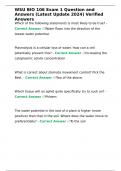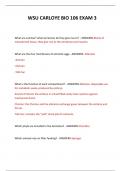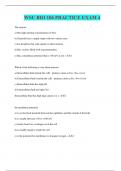Bio 106 wsu - Study guides, Class notes & Summaries
Looking for the best study guides, study notes and summaries about Bio 106 wsu? On this page you'll find 142 study documents about Bio 106 wsu.
Page 4 out of 142 results
Sort by
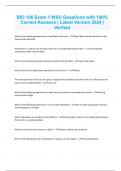
-
BIO 106 Exam 1 WSU Questions with 100% Correct Answers | Latest Version 2024 | Verified
- Exam (elaborations) • 8 pages • 2024
- Available in package deal
-
- $8.49
- + learn more
BIO 106 Exam 1 WSU Questions with 100% Correct Answers | Latest Version 2024 | Verified
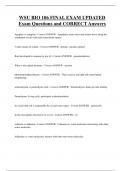
-
WSU BIO 106 FINAL EXAM UPDATED Exam Questions and CORRECT Answers
- Exam (elaborations) • 13 pages • 2024
-
- $9.99
- + learn more
WSU BIO 106 FINAL EXAM UPDATED Exam Questions and CORRECT Answers Apoplast vs symplast - Correct ANSWER- Apoplastic route water and solutes move along the continuum of cell walls and extracellular spaces 3 main tissues of a plant - Correct ANSWER- dermal, vascular, ground Root developed in response to low o2 - Correct ANSWER- pneumatophores What is not a plant hormone - Correct ANSWER- secretin phototropin/phytochrome - Correct ANSWER- These receive red light and control plant morphol...
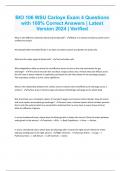
-
BIO 106 WSU Carloye Exam 4 Questions with 100% Correct Answers | Latest Version 2024 | Verified
- Exam (elaborations) • 6 pages • 2024
-
- $8.49
- + learn more
What is the difference between blood and hemolymph? - Blood: In a Closed circulatory system and is confined to vessels. Hemolymph (AKA interstitial fluid): In an Open circulatory system and bathes the body cells. What are the major types of blood cells? - red and white cells What adaptations allow an animal to use diffusion across its skin as the only mechanism for gas exchange? - The animal must be thin and have a large surface area. Animals that only diffuse across the skin have a dense ...
WSU BIO 106 Exam 1 Question and Answers (Latest Update 2024) Verified Answers
WSU CARLOYE BIO 106 EXAM 3 QUESTIONS AND ANSWERS 2024
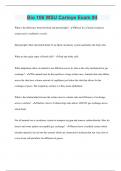
-
Bio 106 WSU Carloye Exam #4 | 2023 | 50 Questions with 100% Correct Answers | Updated & Verified
- Exam (elaborations) • 9 pages • 2023
- Available in package deal
-
- $11.49
- + learn more
What is the difference between blood and hemolymph? - Blood: In a Closed circulatory system and is confined to vessels. Hemolymph (AKA interstitial fluid): In an Open circulatory system and bathes the body cells. What are the major types of blood cells? - red and white cells What adaptations allow an animal to use diffusion across its skin as the only mechanism for gas exchange? - The animal must be thin and have a large surface area. Animals that only diffuse across the skin have a dense ...
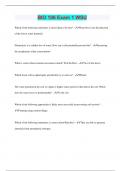
-
BIO 106 Exam 1 WSU
- Exam (elaborations) • 12 pages • 2024
- Available in package deal
-
- $9.99
- + learn more
BIO 106 Exam 1 WSU Which of the following statements is most likely to be true? - Water flows into the direction of the lowest water potential. Plasmolysis is a cellular loss of water. How can a cell potentially prevent this? - Increasing the cytoplasmic solute concentration What is correct about stomata movement control? Pick the Best. - Two of the above. Which tissue will an aphid quite specifically try to suck on? - Phloem The water potential in the root of a plant is higher ...
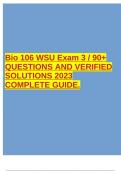
-
Bio 106 WSU Exam 3 / 90+ QUESTIONS AND VERIFIED SOLUTIONS 2023 COMPLETE GUIDE.
- Exam (elaborations) • 7 pages • 2023
-
- $8.49
- + learn more
Bio 106 WSU Exam 3 / 90+ QUESTIONS AND VERIFIED SOLUTIONS 2023 COMPLETE GUIDE. 1. Positive Feedback Loop: Moves a system away from its equilibrium state and make it more unstable 2. Negative Feedback Loop: A feedback loop that causes a system to change in the opposite direction from which it is moving 3. Endocrine System: The system responsible for hormones 4. Steps in a simple pathway: Reception Transduction Response 5. Steps in a cascade pathway: A stimulus (first messenger) activi...
WSU BIO 106 PRACTICE EXAM 4 | Questions with 100% Correct Answers | Latest Update 2024 | Verified
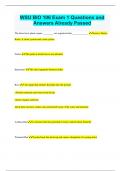
-
WSU BIO 106 Exam 1 Questions and Answers Already Passed
- Exam (elaborations) • 10 pages • 2024
- Available in package deal
-
- $9.99
- + learn more
WSU BIO 106 Exam 1 Questions and Answers Already Passed The three basic plant organs, ________, are organized into_____________. Leaves, Stems, Roots; A shoot system and a root system Nodes The point at which leaves are attached Internodes The stem segments between nodes Root -An organ that anchors the plant into the ground -Absorbs minerals and water from the tip -Stores organic nutrients -Root hairs increase surface area and absorb most of the water and minerals Axillary ...

$6.50 for your textbook summary multiplied by 100 fellow students... Do the math: that's a lot of money! Don't be a thief of your own wallet and start uploading yours now. Discover all about earning on Stuvia

